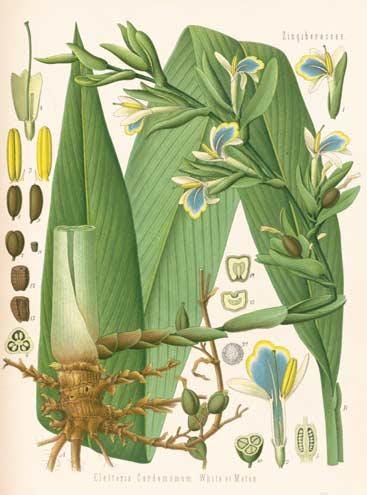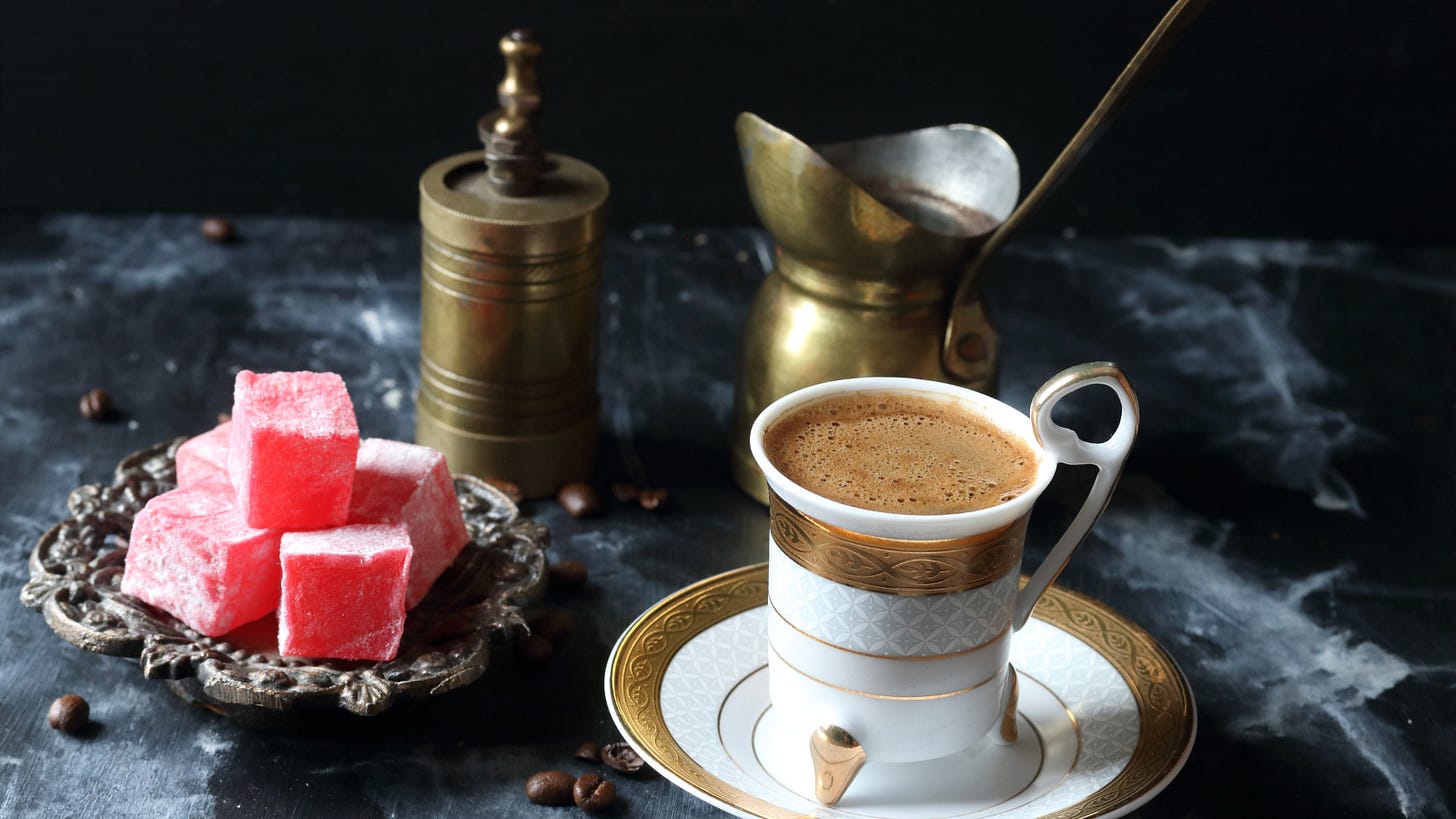The 'Queen of Spices': Green Cardamom
This flavorful member of the ginger family can not only add a special flair to your holiday desserts, but it also has a fascinating history in traditional medicine.

Green cardamom belongs to the ginger family and is known as true cardamom, distinct from black cardamom, which originates from a different species. It is commonly employed in sweet desserts in Middle Eastern and Indian cuisine and ranks as the third most expensive spice globally! If you have ever savored a dark, rich Turkish coffee, that exceptional flavor in the brew is derived from the single cardamom pod included in the recipe.
Botanical Origins

The scientific name of green cardamom is Elettaria cardamomum, and it belongs to the Zingiberaceae (ginger) family, and originates in India. Green cardamom is a perennial shrub with thick, fleshy, lateral roots, capable of reaching a height of up to 8 feet. The fruits of this ginger relative are harvested for the highly aromatic seeds found inside. When mature, the green capsule turns yellow.
Green cardamom was first distinguished from black cardamom in the writings of Theophrastus, the 4th-century Greek scholar who authored "Historia Plantarum" or "Enquiry into Plants." Black cardamom actually comes from another genus, Amomum. The primary type of black cardamom in trade is also known as brown or Nepal cardamom, botanically referred to as Amomum subulatum. It is more commonly used in savory dishes.
Global Market
Although green cardamom is native to India, today it is cultivated on a large scale in other regions across the globe, including Guatemala and Tanzania. I was surprised to learn that Guatemala has actually surpassed India as the largest producer and exporter of green cardamom today. The species was introduced to Guatemala in the 1920s, and as the spice is not well integrated into Central American cuisine, the 13 to 14 thousand tons produced annually are dedicated solely to export. Cardamom is also a costly ingredient, ranking as the third most expensive spice by weight, following saffron and vanilla. Saudi Arabia is the largest global importer of cardamom, comprising 36% of the total market.
To prepare cardamom for export, the capsule fruits are harvested before reaching maturity and then dried either in the sun or using industrial heat sources to prevent them from bursting open and losing the precious seeds inside. When cardamom fruits mature naturally on the plant, they become dehiscent, splitting open to allow the seeds to spread into the environment.
Cardamom is typically sold in the whole fruit form, often displaying a light greenish-brown color following the drying process. When cooking with this spice, the capsule is opened, the seeds are removed, and the outer husk is discarded. This ingredient is rich in powerfully flavorful essential oils, so only a small amount of the seeds is needed to flavor a dish. You may also come across cardamom powder in stores. Just as I recommended avoiding pre-ground black pepper, I hold the same opinion for cardamom. The desirable flavor and taste experience you achieve with freshly ground cardamom are far superior to pre-ground. Like black pepper, the volatile oils responsible for the flavor and pharmacology of this spice will dissipate over time if sold pre-ground, so it's best to opt for whole capsules.
Food Uses
Green cardamom imparts a distinctive flavor to the dishes it enhances, with hints of citrus and even eucalyptus, attributed to the presence of terpenes such as limonene and cineol. This wonderfully aromatic spice is often referred to as the Queen of spices, not only for its delightful aroma and flavor but also for its diverse medicinal applications and its effectiveness as a breath freshener. In fact, the ancient Egyptians obtained this spice through their extensive trade networks and used to chew its seeds as a breath freshener, a practice that still persists in several Arab countries today.
Cardamom holds a revered place in Indian cuisine, serving as an essential ingredient in Indian Chai tea and various sweet desserts. Beyond its association with Camellia sinensis (black tea), this spice also plays a key role in the preparation of Arab-style coffee and Turkish coffee. In Scandinavian countries, it flavors the alcoholic spirit akvavit. Moreover, across Europe, it features prominently as an ingredient in a wide range of sweet desserts, including cookies, cakes, and ice cream.
My first taste of Turkish Coffee
The first time I had traditional Turkish coffee was in the home of an elderly woman who lived in the isolated Sharri Mountains of the Balkans. I was there conducting field research and spent the morning discussing her family's traditions of collecting wild plants in the late spring through the early fall to use as supplementary food ingredients and medicines throughout the year. As was customary in the region to show hospitality to her guest, she offered me a fresh cup of coffee. However, this was not your typical machine-drip brew or even a French press preparation of coffee. I was about to discover the delightful combination of two plants originally from different parts of the world—Ethiopia (coffee) and India (green cardamom).
She began by gathering her ingredients, which included a glass of cold water, a tablespoon of finely ground roasted coffee, a small spoon of sugar, and the seeds from a single cardamom pod, which she ground just before use.
She poured the glass of cold water into the copper ibrik, a small pot with a long handle that could be placed onto a gas burner. She heated the water and sugar until it boiled, then removed it from the hot burner and added the coffee and cardamom. She returned the ibrik to the gas burner and heated it until the coffee began to foam. She pulled it off the heat and repeated this process three times to balance the foam and heat. Then, she poured the thick brew into two small espresso cups, and we waited for the liquid to cool and the coffee sediment to settle at the bottom of the cup before drinking.
When it was ready, I lifted the cup to my nose and took a deep breath. I detected the tones of the delicious coffee, which never fails to stimulate my brain and awaken my senses. However, there were also some unexpected and delightful notes hinting at citrus and ginger. When I finally took a sip, the flavor did not disappoint.
Medicinal History
Green cardamom seeds have a long history of medicinal use. For instance, in traditional Chinese medicine and Unani medicine, they have been employed as carminatives or digestive aids, useful in preventing flatulence and treating painful intestinal gas. In certain medical traditions, the essential oil extracted from the seeds is also incorporated into massage oils and lotions for topical applications, providing an aromatherapy massage experience. This application has been used to alleviate muscle cramps, rheumatic pains, and inflammation. Additionally, due to its pleasing aroma, cardamom has been used as a perfume and was believed to possess aphrodisiac properties.
Chemistry and Pharmacology
The distinctive flavor and aroma of green cardamom seeds can be attributed to a unique blend of volatile compounds found in the seed essential oil. This blend includes 1,8-cineole, limonene, alpha-terpinyl acetate, sabinene, myrcene, alpha-terpineol, and alpha-pinene, among others. Cardamom essential oil is commercially produced through the steam distillation of the powdered fruits, including the husks and seeds.
The traditional use of this spice as a breath freshener and its value as a food ingredient have prompted scientists to investigate the potential antimicrobial properties of green cardamom seed essential oils. Studies have indicated that the essential oil exhibits growth inhibitory activities against various human pathogens and bacteria associated with food spoilage and foodborne illnesses. In addition to its antibacterial properties, antifungal properties of the essential oil have also been observed.
A number of scientific studies have been performed in effort to examine the medicinal potential of cardamom. This review paper does a nice job of elaborating on some of these findings. Here is a brief summary:
Antioxidant Activity
Cardamom contains natural antioxidants that neutralize free radicals.
Presence of phenol compounds like quercetin, kaempferol, and luteolins.
Cardamom essential oil (EO) acts as an antioxidant by scavenging free radicals.
Anticancer Activity
In vitro studies show anticarcinogenic effects, inhibiting DNA damage.
Cardamom oil increases detoxification of xenobiotics.
Phytochemicals like 1,8-cineole and limonene have a protective role against cancer.
Some in vivo studies on animals suggest potential anticancer effects but further human studies are needed.
Antimicrobial and Antibacterial Activity
Cardamom essential oil has robust antibacterial effects against various microorganisms.
There is a need for more robust lab models to be used in assessing these activities.
Insecticidal Activity
Cardamom essential oil shows potential as a grain protectant against insect pests.
Effective against tomato leaf miner.
Limited research in this area, more studies required.
Other Properties
Cardamom essential oil is used in the food industry as a flavoring agent in various foods and beverages, as well as in perfumes and lotions.
Components of cardamom oil enhance the penetration of medicines through the skin.
Cardamom has antispasmodic and diuretic properties.
Some studies suggest cardiovascular activity.
Cardamom may have a protective effect on kidneys when combined with gentamicin.
For all of these reported activities, further research, especially in human clinical trials, is needed to establish the clinical relevance and safety of cardamom products in medicine.
The Takeaway
Who would have thought that another member of the ginger family could be so fascinating, health-boosting, and delicious? Have you ever tried a dish with green cardamom before? Feel free to share your favorite recipes in the comment section below. If you're interested in learning more about this spice, you might find this episode from the Foodie Pharmacology podcast intriguing. In the episode, I visited a local ice cream company in Atlanta—Ice Cream Walla—to discover how they incorporate cardamom into their ice cream recipes and, of course, sampled their delightful treats myself. Happy holidays!
Yours in health, Dr. Quave
Cassandra L. Quave, Ph.D. is a scientist, author, speaker, podcast host, wife, mother, explorer, and professor at Emory University School of Medicine. She teaches college courses and leads a group of research scientists studying medicinal plants to find new life-saving drugs from nature. She hosts the Foodie Pharmacology podcast and writes the Nature’s Pharmacy newsletter to share the science behind natural medicines. To support her effort, consider a paid or founding subscription, with founding members receiving an autographed 1st edition hardcover copy of her book, The Plant Hunter.
Available in hardcover, paperback, audio, and e-book formats!







Great article💕🙏
Very inspiring! Thanks for the history, background, and ideas. I’m feeling like I need to make something with cardamom asap!
Don’t say, I didn’t warn you, these are amazing!
https://www.epicurious.com/recipes/food/views/swedish-cardamom-rolls-14327